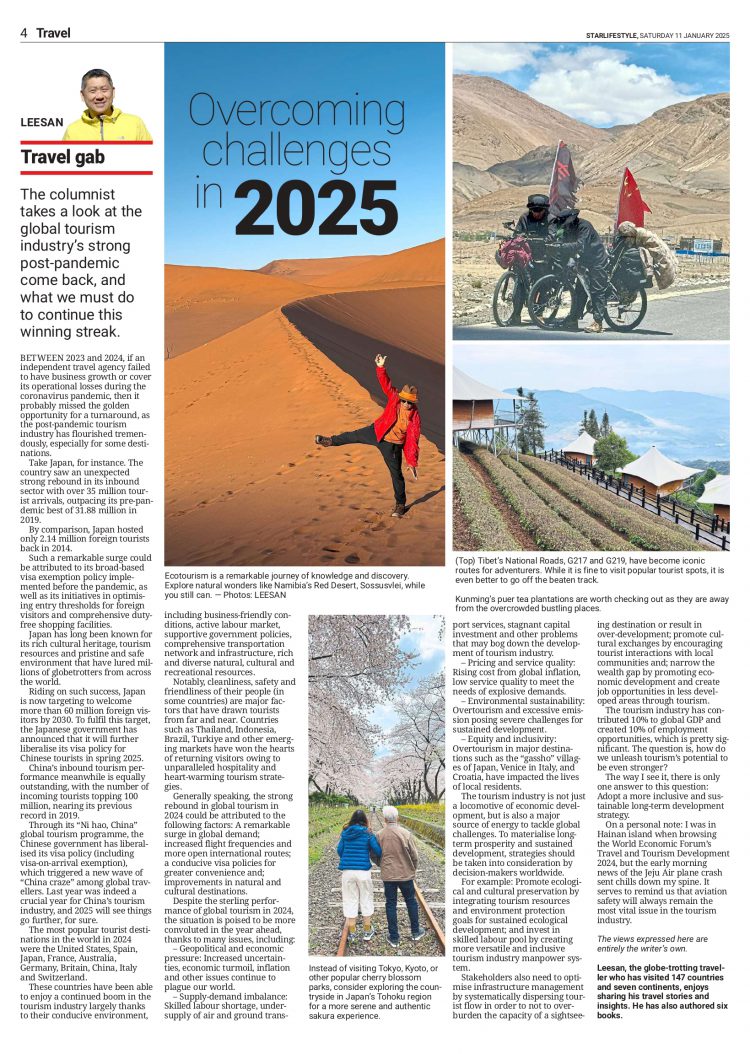Overcoming challenges in 2025 – by leesan
The columnist takes a look at the global tourism industry’s strong post-pandemic come back, and what we must do to continue this winning streak.

Ecotourism is a remarkable journey of knowledge and discovery.
Explore natural wonders like namibia’s red desert, Sossusvlei, while you still can. — Photos: Leesan
BETWEEN 2023 and 2024, if an independent travel agency failed to have business growth or cover its operational losses during the coronavirus pandemic, then it probably missed the golden opportunity for a turnaround, as the post-pandemic tourism industry has flourished tremendously, especially for some destinations.
Take Japan, for instance. The country saw an unexpected strong rebound in its inbound sector with over 35 million tourist arrivals, outpacing its pre-pandemic best of 31.88 million in 2019.
By comparison, Japan hosted only 2.14 million foreign tourists back in 2014.
Such a remarkable surge could be attributed to its broad-based visa exemption policy implemented before the pandemic, as well as its initiatives in optimising entry thresholds for foreign visitors and comprehensive dutyfree shopping facilities.
Japan has long been known for its rich cultural heritage, tourism resources and pristine and safe environment that have lured millions of globetrotters from across the world.
Riding on such success, Japan is now targeting to welcome more than 60 million foreign visitors by 2030. To fulfil this target, the Japanese government has announced that it will further liberalise its visa policy for Chinese tourists in spring 2025.

Instead of visiting tokyo, Kyoto, or other popular cherry blossom parks, consider exploring the countryside in Japan’s tohoku region for a more serene and authentic sakura experience.
China’s inbound tourism performance meanwhile is equally outstanding, with the number of incoming tourists topping 100 million, nearing its previous record in 2019.
Through its “Ni hao, China” global tourism programme, the Chinese government has liberalised its visa policy (including visa-on-arrival exemption), which triggered a new wave of “China craze” among global travellers.
Last year was indeed a crucial year for China’s tourism industry, and 2025 will see things go further, for sure.
The most popular tourist destinations in the world in 2024 were the United States, Spain, Japan, France, Australia, Germany, Britain, China, Italy and Switzerland.
These countries have been able to enjoy a continued boom in the tourism industry largely thanks to their conducive environment, including business-friendly conditions, active labour market, supportive government policies, comprehensive transportation network and infrastructure, rich and diverse natural, cultural and recreational resources.
Notably, cleanliness, safety and friendliness of their people (in some countries) are major factors that have drawn tourists from far and near. Countries such as Thailand, Indonesia, Brazil, Turkiye and other emerging markets have won the hearts of returning visitors owing to unparalleled hospitality and heart-warming tourism strategies.
Generally speaking, the strong rebound in global tourism in 2024 could be attributed to the following factors: A remarkable surge in global demand; increased flight frequencies and more open international routes; a conducive visa policies for greater convenience and; improvements in natural and cultural destinations.
Despite the sterling performance of global tourism in 2024, the situation is poised to be more convoluted in the year ahead, thanks to many issues, including:
– Geopolitical and economic pressure: Increased uncertainties, economic turmoil, inflation and other issues continue to plague our world.
– Supply-demand imbalance: Skilled labour shortage, undersupply of air and ground transport services, stagnant capital investment and other problems that may bog down the development of tourism industry.
– Pricing and service quality: Rising cost from global inflation, low service quality to meet the needs of explosive demands.
– Environmental sustainability: Overtourism and excessive emission posing severe challenges for sustained development.
– Equity and inclusivity: Overtourism in major destinations such as the “gassho” villages of Japan, Venice in Italy, and Croatia, have impacted the lives of local residents.

Tibet’s national roads, G217 and G219, have become iconic routes for adventurers.
While it is fine to visit popular tourist spots, it is even better to go off the beaten track.

Kunming’s puer tea plantations are worth checking out as they are away from the overcrowded
bustling places.
The tourism industry is not just a locomotive of economic development, but is also a major source of energy to tackle global challenges. To materialise longterm prosperity and sustained development, strategies should be taken into consideration by decision-makers worldwide.
For example: Promote ecological and cultural preservation by integrating tourism resources and environment protection goals for sustained ecological development; and invest in skilled labour pool by creating more versatile and inclusive tourism industry manpower system.
Stakeholders also need to optimise infrastructure management by systematically dispersing tourist flow in order to not to overburden the capacity of a sightseeing destination or result in over-development; promote cultural exchanges by encouraging tourist interactions with local communities and; narrow the wealth gap by promoting economic development and create job opportunities in less developed areas through tourism.
The tourism industry has contributed 10% to global GDP and created 10% of employment opportunities, which is pretty significant.
The question is, how do we unleash tourism’s potential to be even stronger?
The way I see it, there is only one answer to this question: Adopt a more inclusive and sustainable long-term development strategy.
On a personal note: I was in Hainan island when browsing the World Economic Forum’s Travel and Tourism Development 2024, but the early morning news of the Jeju Air plane crash sent chills down my spine. It serves to remind us that aviation safety will always remain the most vital issue in the tourism industry.

Published in The Star, 11 Jan 2025
全球超过80000家酒店,Apple101助您轻松订房,出行无忧,绝对优惠价。入住期间付款,多数客房可免费取消!











